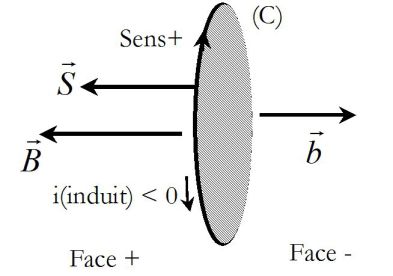Lenz's law
Attention : Lenz's law
The minus sign in Faraday's law of induction is the consequence of the conventions chosen to orient the surface of the circuit and define the electromotive force.
Physically, it is the consequence of the moderating effect of the induced current.
Lenz's law translates this effect qualitatively.
It helps guess the orientation of the induced current in simple cases and verify its sign once the algebraic calculus is done.
Lenz's law :
« The induced current is oriented so that the induced flux it creates opposes the variations of the inductor flux »
Or else :
« The electromotive force tends, through its consequences, to oppose to the cause which gave it birth »
Exemple : Verification of Lenz's law on an example
The variation of the magnetic field
 over time causes a variable magnetic flux through the circuit, which is called “inductor flux”, and of an electromotive force.
over time causes a variable magnetic flux through the circuit, which is called “inductor flux”, and of an electromotive force.
The latter can debit a current in the circuit called “induced current”.

The induced current creates its own magnetic field
 (“induced magnetic field”), responsible for a magnetic flux across the circuit, called “induced flow”.
(“induced magnetic field”), responsible for a magnetic flux across the circuit, called “induced flow”.
If the inductor flux increases (the norm of the field
 increases), its derivative is positive.
increases), its derivative is positive.
Because of Faraday's law of induction, the induced electromotive force is negative.
The induced current is then negative (because
 , where
, where
 is the electrical resistance of the circuit).
is the electrical resistance of the circuit).
The induced flow is then negative when the variation of inductor flux is positive : the induced flow opposes indeed to the variation of the inductor flux.
This illustrates, on this example that Lenz's law is in fact a moderation principle.
Complément : Foucault currents (or Eddy currents)
Simulation : A JAVA animation by Jean-Jacques Rousseau (Université du Mans)
Lenz's law : click HERE





